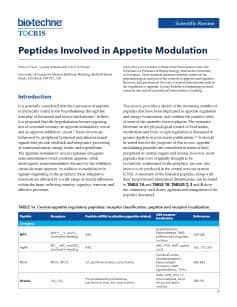GIP Receptor
The GIP (gastric inhibitory polypeptide or glucose-dependent insulinotropic peptide) receptor is a member of the glucagon receptor family that also includes glucagon, GLP-1, GLP-2, secretin and GHRH receptors. The GIP receptor is involved in glucose homeostasis.
GIP Receptor Agonists |
|
|---|---|
| Cat. No. | 产品名称/活性 |
| 2257 | GIP (1-39) |
| Highly potent insulinotropic peptide; GIP agonist | |
| 2084 | GIP (human) |
| Potent insulinotropic gut hormone; GIP agonist | |
| 6699 | [D-Ala2]-GIP (human) |
| Highly potent GIP agonist | |
GIP Receptor Antagonists |
|
| Cat. No. | 产品名称/活性 |
| 5838 | [Pro3]-GIP (Mouse) |
| GIP receptor antagonist | |
The GIP (gastric inhibitory polypeptide or glucose-dependent insulinotropic peptide) receptor is a member of the glucagon receptor family that also includes glucagon, GLP-1, GLP-2, secretin and GHRH receptors. The GIP receptor is involved in glucose homeostasis via potentiation of glucose-dependent insulin secretion from the pancreatic islet β-cells. It also inhibits gastric acid secretion. The tissue distribution of this receptor is broad, with high levels of expression in the islet β-cells. The human GIP receptor gene is localized on chromosome 19q13.3.
External sources of pharmacological information for GIP Receptor :
Literature for GIP Receptor
Tocris offers the following scientific literature for GIP Receptor to showcase our products. We invite you to request* your copy today!
*Please note that Tocris will only send literature to established scientific business / institute addresses.
Peptides Involved in Appetite Modulation Scientific Review
Written by Sonia Tucci, Lynsay Kobelis and Tim Kirkham, this review provides a synopsis of the increasing number of peptides that have been implicated in appetite regulation and energy homeostasis; putative roles of the major peptides are outlined and compounds available from Tocris are listed.
